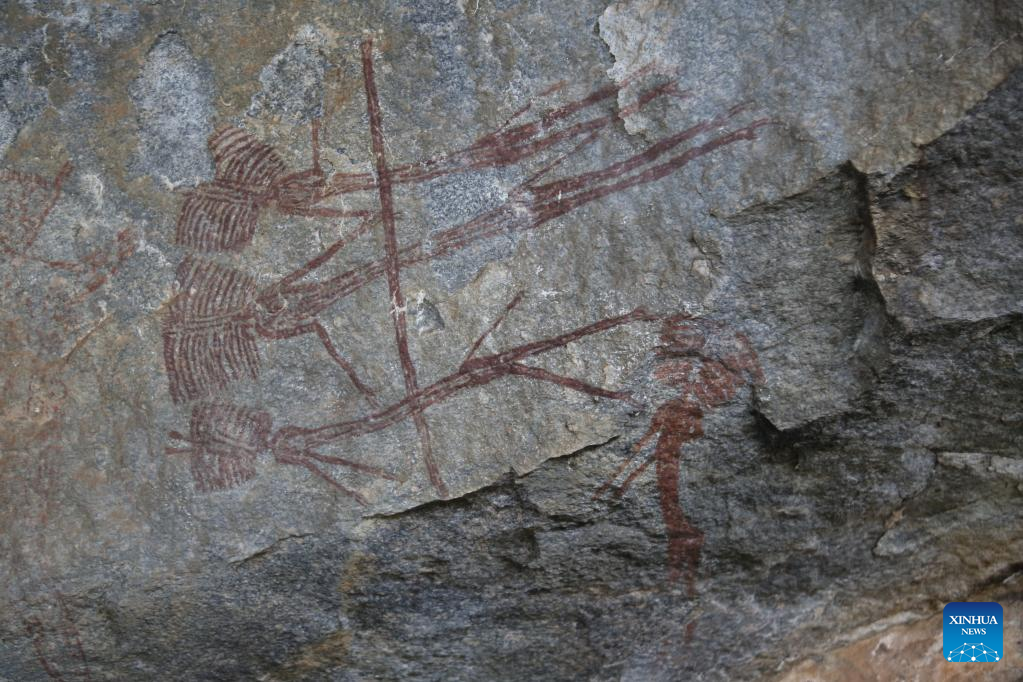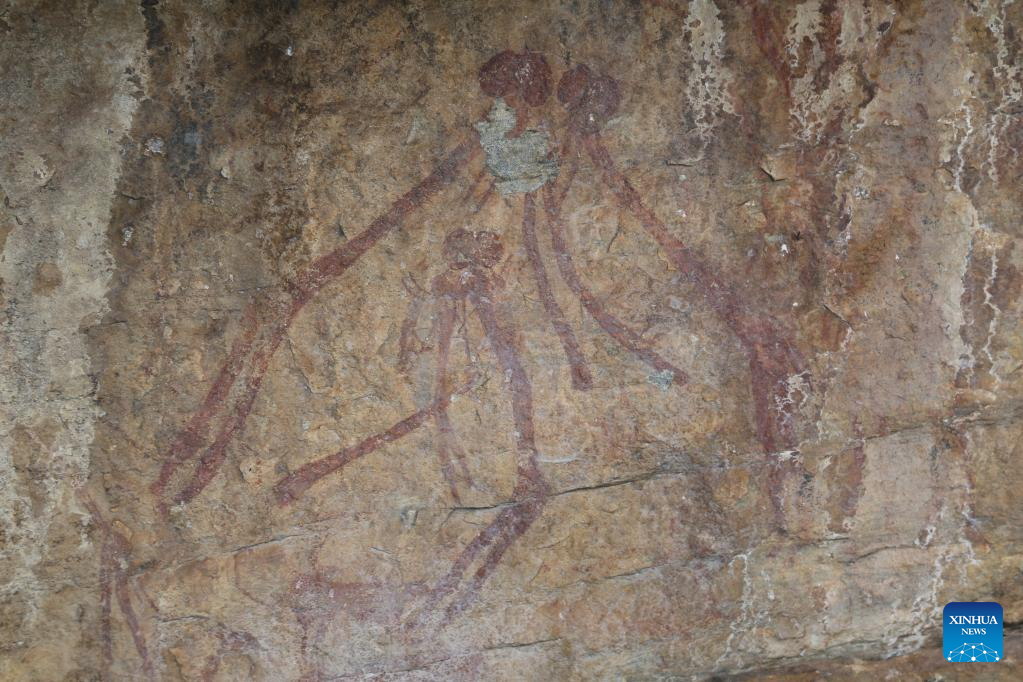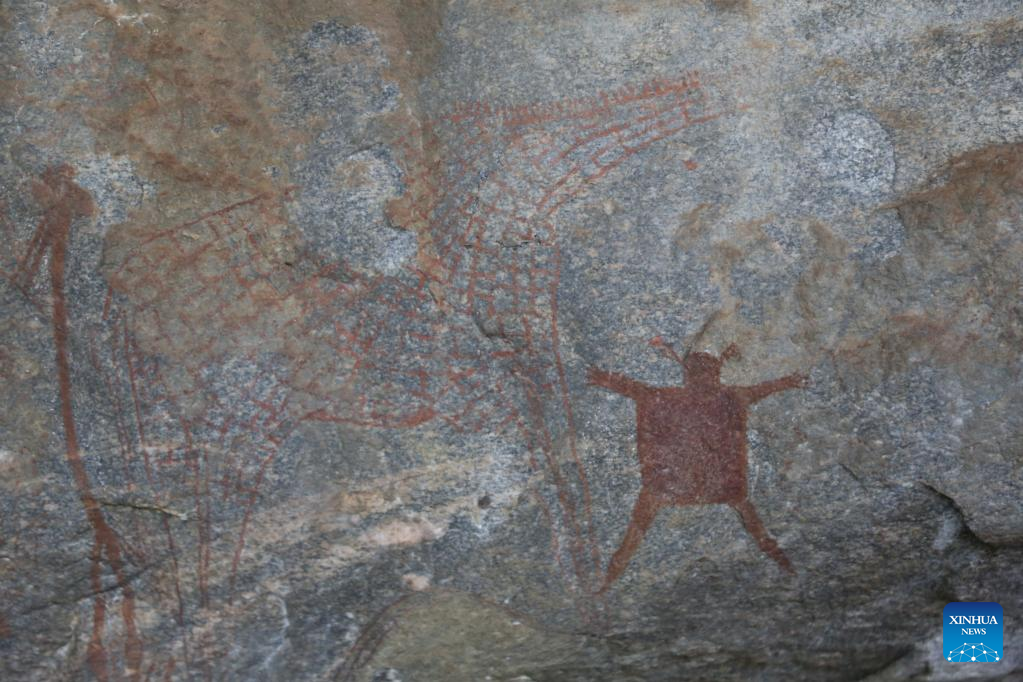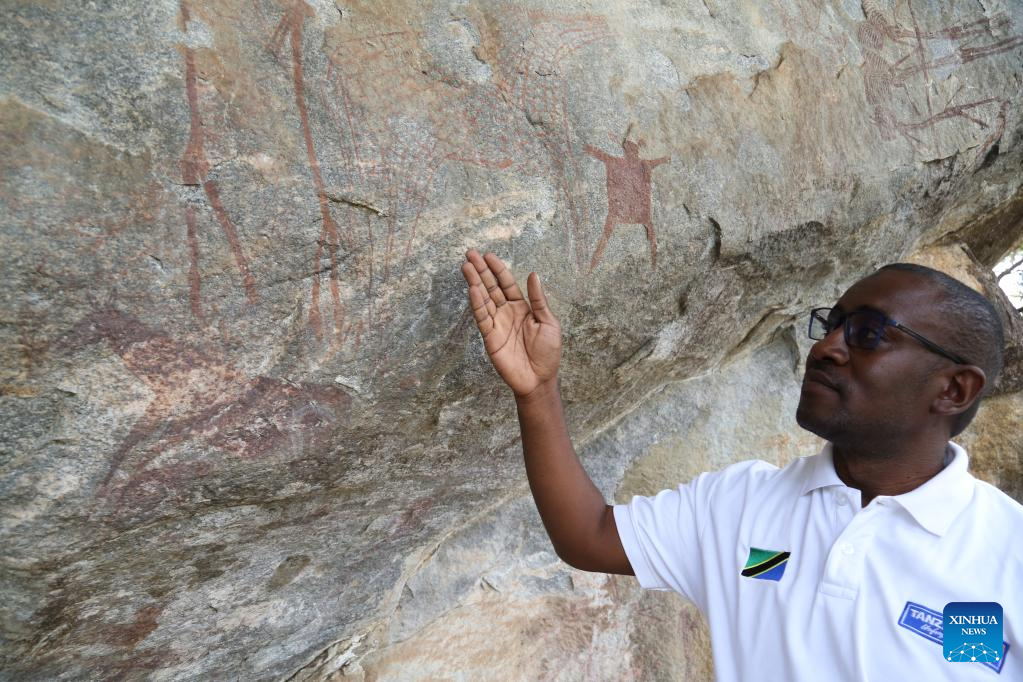
This photo taken on June 26, 2023 shows a petroglyph found in Kondoa, Tanzania. A visit to the Kondoa Rock Art Sites, a series of ancient paintings on rock shelter walls in central Tanzania, leaves one with a treasure trove of knowledge about the pre-historic rock art. (Photo by Herman Emmanuel/Xinhua)
KONDOA, Tanzania, July 1 (Xinhua) -- A visit to the Kondoa Rock Art Sites, a series of ancient paintings on rock shelter walls in central Tanzania, leaves one with a treasure trove of knowledge about the pre-historic rock art.
The paintings, about 20 km north of Kondoa town in Dodoma region, were declared a UNESCO World Heritage Site in 2006. The existence of rock paintings in the area was first reported in 1908, and it was declared a conservation area in 2004, according to the United Nations Educational, Scientific and Cultural Organization (UNESCO).
Though under strict protection, the conservation and preservation of the rock art sites is challenged by the impact of climate change, said Zuberi Mabie, manager for the Kondoa Rock Art Sites.
Mabie said he was worried that climate change was posing a significant threat to the survival of the sites.
"Rock arts like any other tangible heritage, have been affected by the impact of climate change through weathering as the rise of temperatures causes rock disintegration," he told Xinhua in a recent interview.
The wiping out of vegetation covers caused by climate change has led to the movement of dust toward rock surfaces, Mabie said, adding that excessive rainfall, also caused by climate change, leads to water passage through the rock art and finally damages the art.
He said the paintings are also facing manmade problems, including animal grazing because the sites are located in the middle of the forest.
"There are people who want to bring their animals for grazing. This is a problem because if you bring animals in this place, it is very much easy for a cow to come and scratch its back across the rock surface which actually may tarnish the arts," Mabie said.
He added that there are also some ritual activities that involve the use of local brews which they sometimes pour across the rock surface.
"The local brew sticks to the rock surface and fades the arts. We are doing all the best to make sure that these challenges are tackled," he said.
Mabie said new technology on the conservation of rocks is needed to address some of the challenges facing the paintings, adding that they are struggling to look for people who have that new technology to deal with natural factors like the penetration of rainwater through the rocks to the arts.
Unfortunately, he said that technology is not available in Tanzania.
"Countries like China that have that technology can help us. It is very much appreciated if China can help us with that technology and training," Mabie said.
He said another best way of protecting the rocks is to work closely with the local communities who are the custodians of these rock arts.
Mabie said currently there are more than 450 recorded paintings sites scattered across 13 villages in Kondoa district. However, he does not have an exact number of paintings in the other parts of Tanzania. Researchers have started to document rock arts in Manyara, Kagera and Iringa regions.
He said 6,000 domestic and foreign tourists visit four selected sites annually, most of whom come from China, Germany, France, the United States, Canada and Switzerland.
These pre-historic arts which are the earliest ways of communication between generations to generations need to be protected, preserved and conserved for today's generation and future generations, said Mabie.
He said the Kondoa rock paintings have many different values, including socio-economic values and spiritual values for the people who live within the rock art sites. "Local communities use this place as an area for spiritual connection between their ancestors and their living of everyday activities."
Mabie added that the sites have educational value because it is through them that school kids and students learn about the country's history and society.
"Researchers also come here and do archaeological research on issues about the age of the paintings and different cultural activities in this area," he said. ■

This photo taken on June 26, 2023 shows a petroglyph found in Kondoa, Tanzania. A visit to the Kondoa Rock Art Sites, a series of ancient paintings on rock shelter walls in central Tanzania, leaves one with a treasure trove of knowledge about the pre-historic rock art. (Photo by Herman Emmanuel/Xinhua)

This photo taken on June 26, 2023 shows a petroglyph found in Kondoa, Tanzania. A visit to the Kondoa Rock Art Sites, a series of ancient paintings on rock shelter walls in central Tanzania, leaves one with a treasure trove of knowledge about the pre-historic rock art. (Photo by Herman Emmanuel/Xinhua)

Zuberi Mabie, manager for the Kondoa Rock Art Sites, presents some of the petroglyph found in Kondoa, Tanzania, on June 26, 2023. A visit to the Kondoa Rock Art Sites, a series of ancient paintings on rock shelter walls in central Tanzania, leaves one with a treasure trove of knowledge about the pre-historic rock art. (Photo by Herman Emmanuel/Xinhua)



